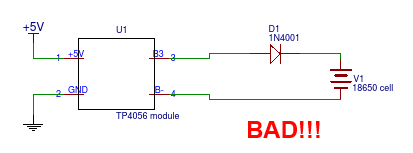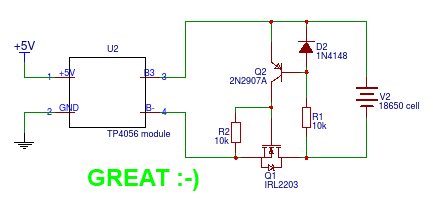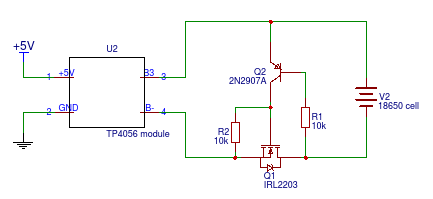18650 Battery charger reverse polarity protection
By Vince on 2017-12-22, 00:23 - Geek - Permalink
Introduction
Having many 18650 battery cells to charge, I bought a few dirt cheap TP4056 modules (0.22 EUR per piece) and discovered that they are "not designed for" reversed polarity cells. In other words, reversed battery = instant magic smoke.
As I know for sure I will insert more batteries in the wrong orientation again sooner or later, I wondered what the best reverse polarity protection would be. This thread addresses this very topic, but at the time of this writing, it ends with:
Q: "Has anyone actually tested this solution in real life?"
A: "Good question..."

So I thought I would test and share the results here.
Note: Sorry for the audio quality of the videos, they are almost straight from my phone and I chose to spend more time on writing rather than on video editing... Also please don't take into account the aspect of the assembled circuits, remember these are quick and dirty tests.
Here are the ideas that were developed in the thread:
1. Simple Diode in series with the cell :

Big NO-NO !
The naive logic is that the diode only allows the current to flow "in one direction", but this logic is flawed because the battery is not a load (a random circuit) that we want to protect from a reversed voltage source, the battery is a voltage source. In other words, we don't want to protect the charger from a battery with a voltage > 4.2V that would make the current flow from battery to charger, instead we want to protect the charger from a battery with a voltage < 0V (reversed). If the battery is reversed, the current will not be reversed: it will still flow "clockwise", but both the battery and the charger will "push" it the same way, and the diode will happilly let that happen of course. Current will skyrocket as if there was no diode, and magic fume will come again.
Moreover, when the battery is correctly connected, this solution is not good either because even with a very low forward voltage diode (e.g. 0.4V with this shottky diode), that voltage drop in series with the battery will make the TP4056 think the cell has reached its 4.2V when it's really only at 3.8V, and the battery will never get fully charged as it should.
Verdict: That solution is BAD. It doesn't solve the problem and adds other issues.
2. Polyfuse + clamp diode :

The logic here is that we place a (normally reverse-polarized) diode in parallel with the charger's output. If the battery is connected the right way, this diode is blocking and does nothing. But if the battery is reversed, that diode will basically short-circuit it, causing a current surge through the battery. A fuse between the diode and the battery will then blow and "disconnect" the battery, saving both the battery and the charger.
The first problem is that, as explained, a current surge is required for the protection to trigger, so even with a fast fuse, a current surge WILL happen. Moreover, during that surge, the diode will short circuit the battery, but also the charger (effectively, the charger will see the forward voltage drop of the diode). Only a test will tell if the charger survives that short-circuit.
Now if the "fuse" is an actual "single-use" fuse, it will have to be replaced each time a battery is wrongly inserted, and one might wonder if it's worth the hassle, because TP4056 modules are almost as cheap as the fuses themselves  .
.
The other option is to use a "Polyfuse" or "Polyswitch", acting as a resettable fuse. Technically, it's a temperature-variable resistor (PTC) which would ideally have a 0-ohm resistance at ambiant temperature, and an infinite resistance above a threshold temperature, that temperature being reached when a given current passes through it.
That option is the exact setup I tested:
As observed, the TP4056 module withstands the short-circuit and is saved by the protection.
Polyfuses are not ideal though: the current that causes the resistance to rise is not a precise value. For example, the 1.1A polyfuse I used for the test is guaranteed to "hold" 1.1A without triggering ("tripping"), and is guaranteed to "trip" at 2.2A (ambiant temperature, still air). More important, the time it takes to trip can be as high as 5 seconds! So although the cell should not blow, it is definitely not designed to be short-circuited for 5 seconds.
Moreover, being a resistor, the polyfuse will also dissipate some power (and cause a voltage drop) when the cell is being charged at high currents. This is not really a big deal because it will just make the charge less efficient. As the battery charges, the current will decrease, and so will the voltage drop on the polyswitch. In the end, we will still get a fully charged cell, even if it takes a bit more time and power than without the polyswitch.
Finally, when the cell is reversed, the polyswitch will continue to limit the current as long as it remains hot, and it will remain hot as long as current is flowing through it. Practically speaking, it means that as long as the cell is left in the wrong orientation, it will get discharged through the diode and polyfuse, with no overdischarge protection... As the battery is probably already empty (why would you want to recharge it otherwise ?), if you don't notice the issue fast enough, the protection will save the TP4056 but kill the cell.
Verdict: OK for temporary protection
3. MOSFET

We come back to the idea of "preventing the current from flowing" (as in 1) instead of letting it flow and protecting the charger (as in 2), but we do it the right way this time, using a MOSFET as a switch.
When OFF, the mosfet does not let any current through, effectively opening the circuit like a reverse-polarized diode. When ON, it behaves more like a resistor with a very low resistance, causing a voltage drop that decreases as the cell becomes full and current slows down. That is good.
Now, the trick is to have the gate turning the switch On or Off at the right moment. The first thing is to put a resistor from the source to the gate to make sure the MOSFET is OFF "by default", and the second thing is to add a transistor to override that resistor and flip the voltage on the gate when the battery is correctly positioned.
I didn't have P-channel mosfets laying around as most circuits use N-channel ones, so I built the exact mirror of the above circuit (note the NPN transistor becomes a PNP) :

And here is the test:
As you can see, the protection works perfectly. There is no current surge when cell is reversed, the charger sees no battery connected and uses no current. On the battery side, the current drained from the cell is also negligible. This circuit is clearly the safest one for distracted or careless people like me.
Verdict: Very effective protection.
Now the MOSFET I randomly selected (2N7000) is not the best as its resistance when ON (RdsOn) is quite high, possibly more than 5 Ohm at Vgs = 4.5V according to the datasheet. In the conditions of the test, the voltage/current ratio gives a more typical value of around 1.5 Ohm, but that means that part of the power used during charging is lost as heat (1.5W at 1Amp), causing the charge to take longer than needed. After screening through my salvaged parts bin, I came across a IRL2203 MOSFET from a dead power supply, which has a RdsOn of only 0.007 Ohm. In other words, the circuit is now:

So I tested with that MOSFET and the result is almost perfect :
The protection works as before but now, in normal use, the voltage drop across the mosfet is reduced to a negligible value, So the behaviour is almost perfect.
Verdict: Great solution!
Side-note: although the logic is different, using a N-channel mosfet with a low RdsOn as a switch on the B- connection is also the method used on the "protected" version of the TP4056 module (it's a pity they didn't include the reverse polarity protection while they were at it). That module includes a FS8205A dual mosfet chip with a typical RdsOn of less than 0.03 Ohm.
Now I admit I'm a bit puzzled (and always was) about the additional diode. It is found in many circuits dealing with "reverse voltage protection" as a way to make sure the reverse voltage between base and emitter of the transistor doesn't go below -5V (for 2N2222), which would be "out of spec". It's just a small diode, it doesn't have to carry high current, it's cheap, so not a big deal, but as we're only dealing with a Li-Ion cell, even if reversed when fully charged, it won't ever go below -4.2V.
So I think it could be left out...
...
...
...
... but I hear your disappointment: If you're reading this, you can't be satisfied with a post that ends with "I think...". If you're reading this, it's because you want to see chips burst in flames  . So I had to do one last test with the following circuit:
. So I had to do one last test with the following circuit:

And here we go for the test:
Verdict: ... just watch the video 
Note: in any case, it may be a good idea to add an indicator when the battery is connected the wrong way. The obvious solution is a LED in series with a resistor, that would light up only when the battery is reversed, but maybe it would be wiser to add an active buzzer in series with a diode. If you build a multi-cell charger, a single buzzer and one diode per cell is sufficient.
If you want to share opinions/ideas/chips/rants/etc., feel free to comment in the original forum thread.
Hope it helps !